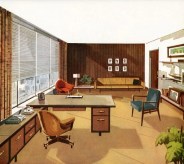Kim Kardashian is in legal hot water — again — for making dubious claims about products online. This time, it centers on one of the most exclusive pieces of American furniture released in the last fifty years.
If you’re already confused about the premise of the story, you’re not alone, nor are you high. Here’s a rundown of the strange controversy capturing the design community’s attention.
The controversy stems from a video in which Kardashian claimed the company owned a very rare and expensive table set. It was actually a knock off
The reality TV star turned business mogul posted a video titled “Welcome to My Office! Official Skkn by Kim Office Tour” in August of 2022, which has since been taken down due to recent legal action, though you can still find it via a quick Google search elsewhere.
The nearly 13-minute video featured Kardashian giving viewers a behind the scenes look at her makeup company SKKN BY KIM’s meticulously designed California office space. Roughly 2:28 into the video, she walks into the company’s kitchen and eating space while drawing particular attention to a distinctive table and chairs. As Kardashian states, “If you guys are furniture people because I’ve really gotten into furniture lately, these Donald Judd tables are really amazing and totally blend in with the seats.”
To those unfamiliar with Donald Judd’s work, the statement could have easily been dismissed as another random Kardashian flex. But her word choice has now sparked a lawsuit.
Kim Kardashian and the office table’s maker are now being sued for trademark and copyright infringement
This week, the Judd Foundation, which “maintains and preserves Donald Judd’s permanently installed living and working spaces, libraries, and archives in New York and Marfa, Texas” and is led by his daughter Rainer Judd, filed a lawsuit against Kardashian as well as California-based Clements Design, the maker of the knockoffs at the center of the dispute.
Clements Design states that the Judd Foundation’s claims are unfounded. Specifically, they have called out that various design details make their table and chairs distinct, including the furniture’s dimensions and wood types, which differ from Judd’s original designs.
To counter these claims, the Judd Foundation has called out details in an invoice from Clements Design for the furniture. The document in question apparently references Donald Judd by name when describing the SKKN BY KIM office furniture as and also includes an image of an authentic Donald Judd dining set as a point of reference. The foundation believes this is evidence that both Kardashian and Clements Design were aware that the table set copied Judd’s work.




